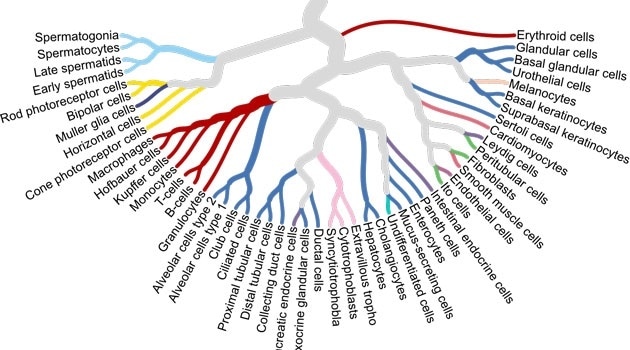Recent research published in Science Advances, a US journal, presents a single cell type map of human tissues. An open-access atlas containing more than 250,000 interactive plots has been launched to enable scientists to examine the expression in individual single cell types for all protein-coding genes in these tissues.

The relationship between some of the major human cell types analyzed in the publication by Karlsson et al. (2021). Image Credit: Human Protein Atlas.
The new knowledge portal is developed as part of the Sweden-based Human Protein Atlas program (www.proteinatlas.org) merging single-cell data with antibody-based profiling to enable a holistic cell-, tissue-, and organ-wide map of the proteins across the human body to serve as a foundation for research in human biology and disease.
The drastic progression in massively parallel sequencing together with single-cell sample preparations and data deconvolution enabled single-cell RNA sequencing to become a robust approach to characterize single cells. In the study by Karlsson et al., single-cell analysis using both RNA sequencing and antibody-based profiling have been merged to develop a publicly available map of 192 human cell types.
Cell types sharing similar functions
The analysis outlines distinctive expression clusters relating to cell types sharing similar functions, both within the same organs and between organs. A classification to map the gene expression profile of all protein-coding genes among different cell types was carried out to analyze the number of genes elevated in particular single cell types, thereby showcasing high or low cell-type specificity.
Among all analyzed cell types, almost 14,000 genes exhibited an elevated expression in specific cell types, of which around 2,000 genes were discovered to be specific for only one of the cell types.
Cell types in testis exhibited the highest numbers of cell type elevated genes, followed by ciliated cells. Intriguingly, only 11% of the genes were identified in all analyzed cell types, implying that the number of essential genes (“house-keeping”) is interestingly less.
According to Mathias Uhlén, the director of the Human Protein Atlas consortium, “The paper describes an important addition to the Human Protein Atlas, which has become one of the world’s most visited biological databases, harboring millions of web pages with information about all the human protein-coding genes.”
We are excited that the new open access Single Cell Type section constitutes a unique resource for studying the cell type specificity and exact spatial localization of all our proteins.”
Dr Cecilia Lindskog, Head, Human Protein Atlas Tissue Profiling Group, Uppsala University
Source:
Journal reference:
Karlsson, M., et al. (2021) A single-cell type transcriptomics map of human tissues. Science Advances. doi.org/10.1126/sciadv.abh2169.